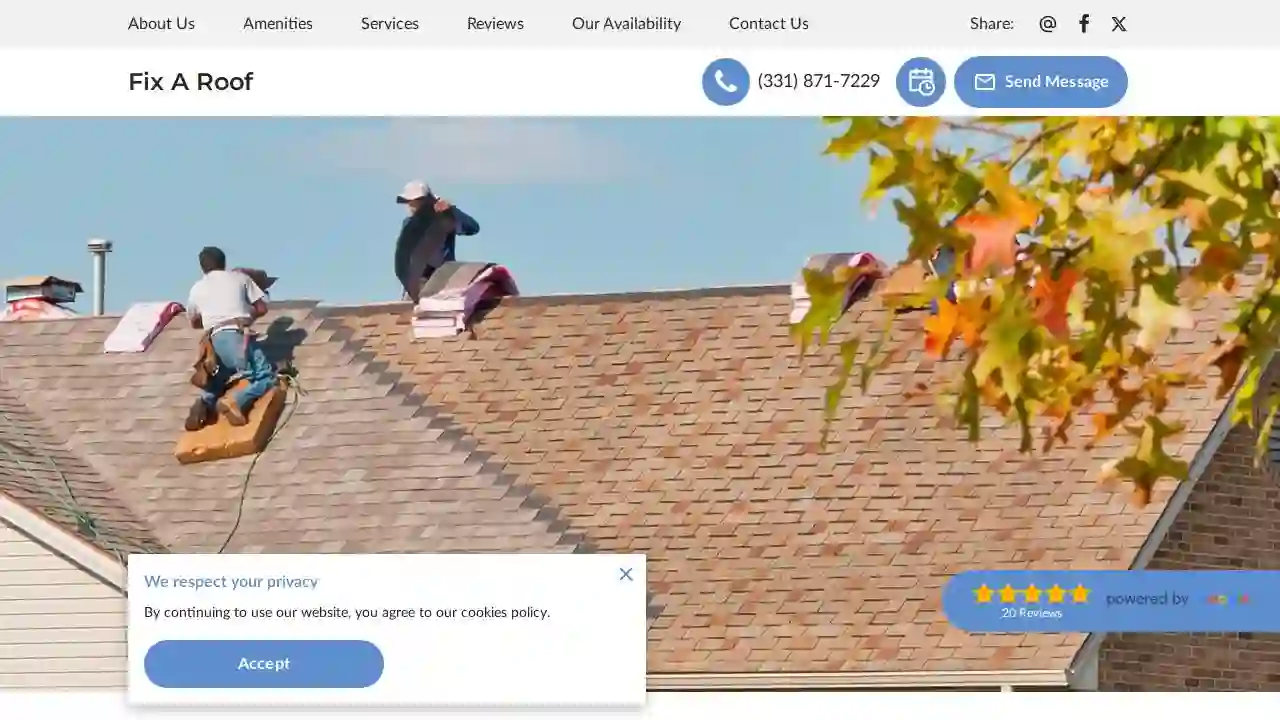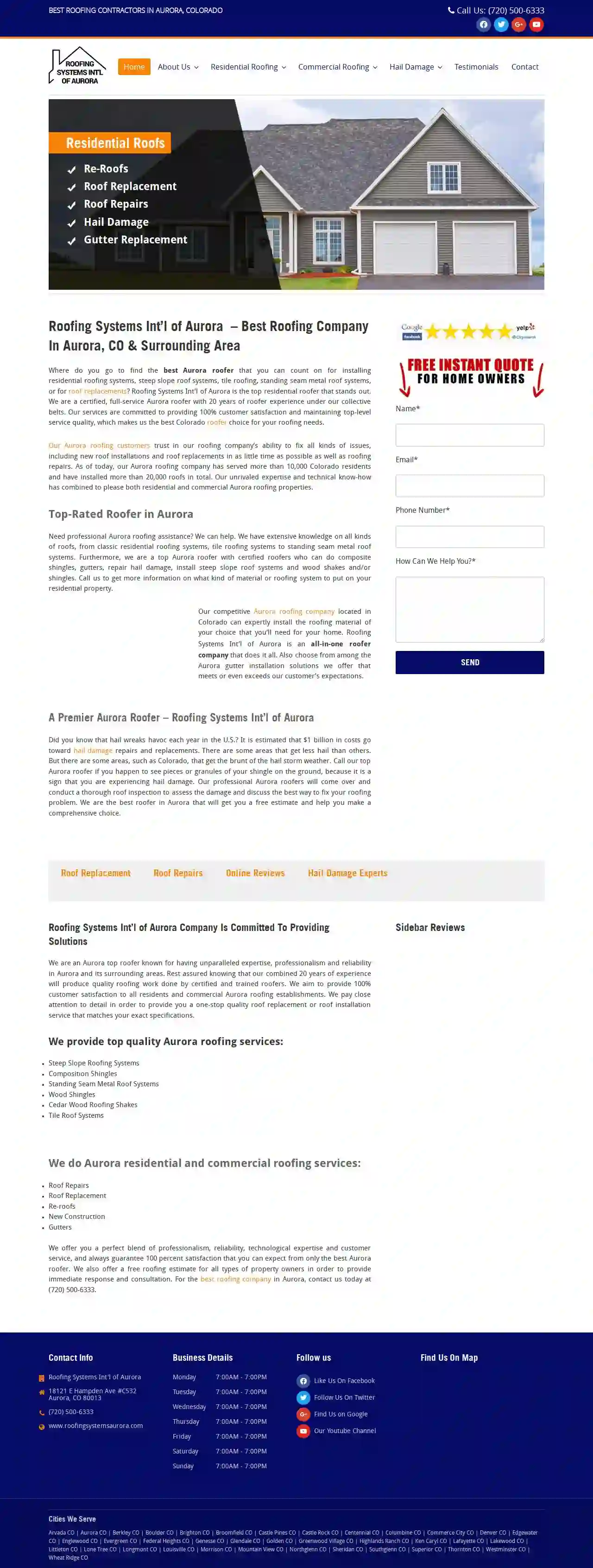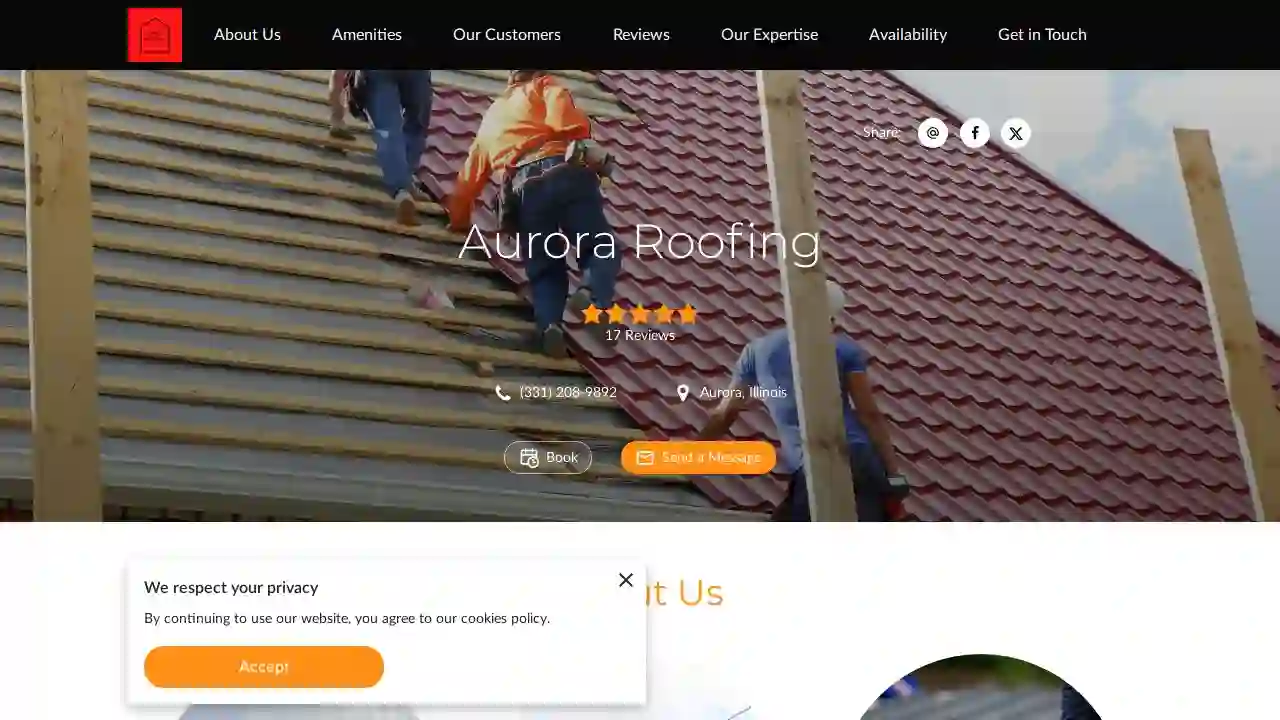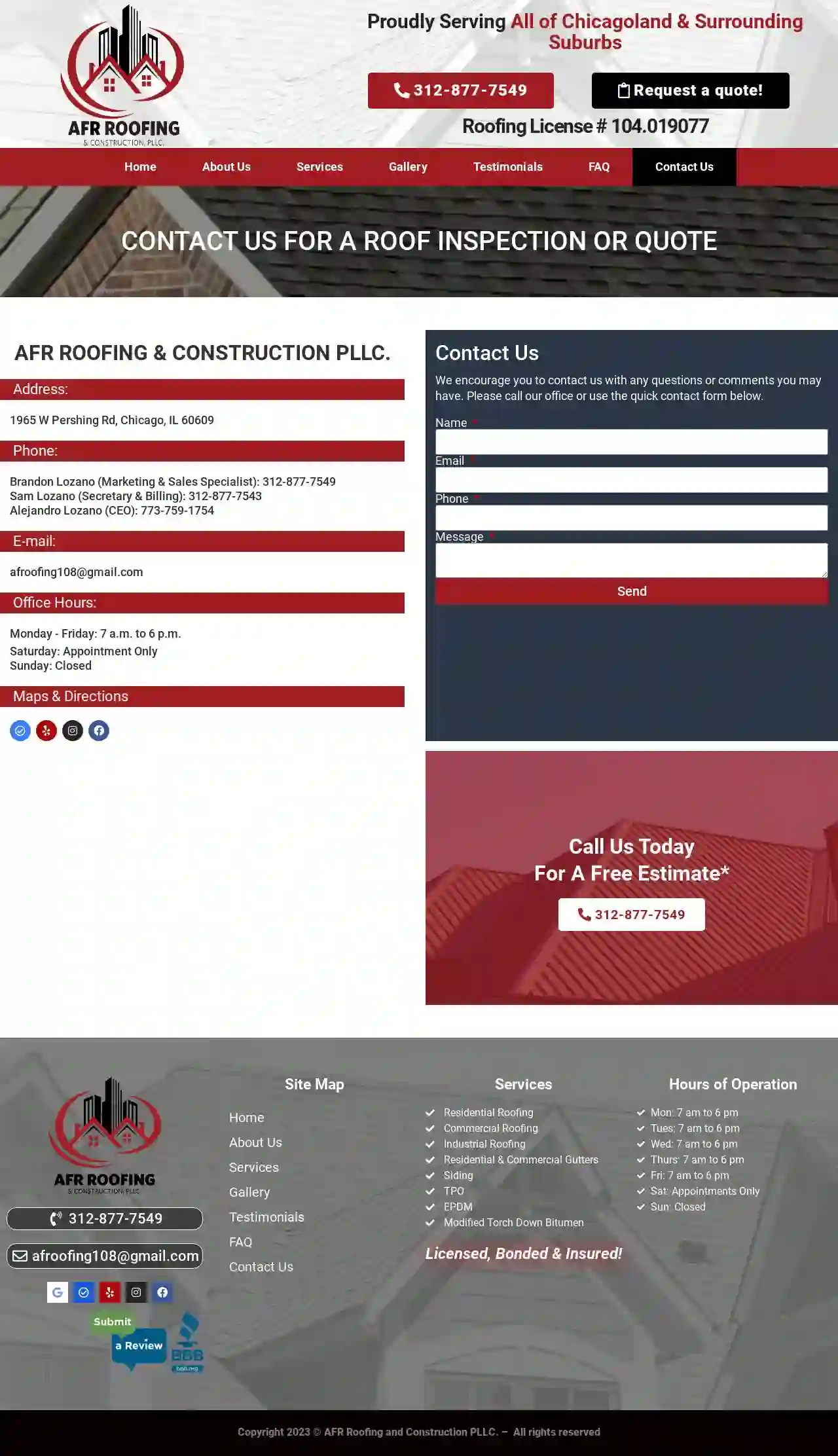Roofing Companies Vernon Hills
Top Roofing Services in Vernon Hills
Get multiple Roofing Services quotes for your project today! Compare profiles, reviews, accreditations, portfolio, etc... and choose the best service.

Superior Roof Repair of Rockford
4.947 reviews515 Pearl St, Belvidere, 61008-7999, USSuperior Roofing has a reputation for providing homes and businesses with high-quality renovations using the best materials and greatest craftsmanship since 1997. We pride ourselves on outstanding customer service and amazing results. We are a Master Elite Contractor for GAF, offering a 50-year non-prorated warranty on all roofing material and labor, plus a 25-year workmanship guarantee. Serving Northern Illinois, Southern Wisconsin, and the Chicagoland Area. If you’re looking for the best roofing companies in this area, then you’ve come to the right place.Our teams have roofed thousands of homes and businesses.
- Services
- Why Us?
- Accreditations
- Testimonials
- Gallery
Get Quote
George Roofing & Construction
4.724 reviewsChicago, 60638, USWelcome to George Roofing & Construction, your trusted source for top-quality residential and commercial roofing services. With our extensive expertise and unwavering commitment to customer satisfaction, we offer a comprehensive range of roofing solutions tailored to meet your specific needs. Whether you require roof installation, repair, or replacement, our skilled team is here to deliver exceptional results. We understand that your roof is a vital component of your property, providing protection and enhancing its overall aesthetic appeal. That's why we utilize the latest industry techniques and premium materials to ensure durable and visually appealing roofs that withstand the test of time.
- Services
- Why Us?
- Testimonials
- Gallery
Get Quote
Fix A Roof
512 reviewsChicago, USFix A Roof is Chicago's premier roofing company, dedicated to providing top-notch service for all your roofing needs. Whether you require a small repair or a complete roof replacement, our team of experienced and skilled roofers is here to help. We pride ourselves on our competitive pricing, ensuring you receive exceptional value for your investment. Our expertise spans a wide range of roofing services, including storm damage repairs, storm-proofing, shingle roofs, metal roofs, and more. Don't let a roofing issue cause you stress. Contact us today for a free quote or fill out our request form to discuss your specific requirements. We understand that a new roof can be a significant undertaking. That's why we provide detailed quotes outlining every aspect of the project, from the scope of work to the associated costs and estimated completion time. With Fix A Roof, you can rest assured that you're receiving a fair price for quality workmanship.
- Services
- Why Us?
- Testimonials
- Gallery
Get Quote
Maximus Roofing
3.412 reviewsAurora, USAt Maximus Roofing LLC, we specialize in residential and commercial roofing services in Aurora, Colorado. With 20 years of experience, our team of experts provides high-quality roofing solutions to homeowners and businesses in the area. From roof repair to installation and maintenance, we do it all. We understand the importance of a well-built roofing infrastructure and strive to ensure the longevity and durability of your roof. Contact us today to learn more about our services and get your free inspection.
- Services
- Why Us?
- Gallery
Get Quote
Scaduto Solutions LLC
511 reviews9957 North Alpine Road, Suite 102, Machesney Park, 61115, USScaduto Solutions is a family-owned roofing business dedicated to providing high-quality roofing and siding solutions for residential and commercial customers. With over 20 years of experience in the industry, they strive to deliver exceptional service and quality workmanship, exceeding customer expectations. Their commitment to customer satisfaction is evident in their transparent and communicative approach, ensuring a seamless experience from initial consultation to final invoice. Scaduto Solutions believes in empowering their customers with knowledge and resources throughout the process. Justin, the owner, started the business with a passion for finding practical solutions that benefit both customers and their families. They are committed to serving their community and making the roofing process stress-free for their clients.
- Services
- Why Us?
- Our Team
- Gallery
Get Quote
Roofing Systems Int'l of Aurora
521 reviewsAurora, USRoofing Systems Int'l of Aurora is the top residential roofer that stands out. We are a certified, full-service Aurora roofer with 20 years of roofer experience under our collective belts. Our services are committed to providing 100% customer satisfaction and maintaining top-level service quality, which makes us the best Colorado roofer choice for your roofing needs. Our Aurora roofing customers trust in our roofing company's ability to fix all kinds of issues, including new roof installations and roof replacements in as little time as possible as well as roofing repairs. As of today, our Aurora roofing company has served more than 10,000 Colorado residents and have installed more than 20,000 roofs in total. Our unrivaled expertise and technical know-how has combined to please both residential and commercial Aurora roofing properties.
- Services
- Why Us?
- Gallery
Get Quote
Aurora Roofing
4.912 reviewsAurora, USAt Aurora Roofing, you'll find a family run and owned business in Aurora with years of experience. Rest assured, we are the roofers – all the work is done in-house. We pride ourselves on our commitment to quality and customer satisfaction. Discovering a leak in your roof can be a real worry, but our team of fully trained and experienced roofers are able to quickly and easily fix all manner of roofing problems. We approach all our projects with the same commitment and professionalism and we’re proud of our hard-earned reputation for skilled workmanship and reliability.
- Services
- Why Us?
- Testimonials
- Gallery
Get Quote
AFR Roofing & Construction PLLC.
56 reviews1965 W Pershing Rd, Chicago, 60609, USAFR Roofing & Construction is a professional roofing company serving the Chicagoland area for over 30 years. We understand that hiring a roofing contractor can be a daunting task, but we take pride in every installation and stand behind our work with a rock-solid warranty. Our team of experienced professionals uses only the highest quality materials and best practices to ensure a quality installation that will look great and provide the functionality you desire. We are fully insured and locally owned, making us the perfect choice for your next roofing project.
- Services
- Why Us?
- Our Team
- Testimonials
- Gallery
Get Quote
Innovative Home Concepts Champaign-Urbana
52 reviews1000 W. Main Street, Suite 100, McHenry, 60010, USInnovative Home Concepts was founded in 2005, since then we have helped thousands of homeowners with their roofing, siding, gutter, and window projects. Since 2007, Innovative has been one of the premier insurance restoration companies in the Midwest. "We have become so good at helping folks through the process of making an insurance claim for hail and wind damage that now most of our business comes from homeowner and insurance agent referrals." -Rhett Wilborn, President of Innovative. Insurance restoration work goes far beyond being just a roofing contractor. A good restoration company of course needs to know the ins and outs of roofing a home or business, but they also need to understand the insurance claims process inside and out. They need to be able to communicate effectively with insurance adjusters and advocate for their clients to ensure they receive fair and timely compensation for their losses. At Innovative Home Concepts, we pride ourselves on our expertise in insurance restoration. Our team of experienced professionals is dedicated to providing our clients with the highest level of service and support throughout the entire claims process. We will work tirelessly to ensure that you receive the maximum amount of compensation for your damages. More than Just a Roofer Insurance restoration work goes far beyond being just a roofing contractor. A good restoration company of course needs to know the ins and outs of roofing a home or business, but they also need to understand the insurance claims process inside and out. They need to be able to communicate effectively with insurance adjusters and advocate for their clients to ensure they receive fair and timely compensation for their losses. At Innovative Home Concepts, we pride ourselves on our expertise in insurance restoration. Our team of experienced professionals is dedicated to providing our clients with the highest level of service and support throughout the entire claims process. We will work tirelessly to ensure that you receive the maximum amount of compensation for your damages.
- Services
- Why Us?
- Accreditations
- Our Team
- Testimonials
- Gallery
Get Quote
Economy Roofing
3.915 reviews3115 S Kostner Ave, Chicago, 60623, USEconomy Roofing is a trusted Chicago roofing company with over 35 years of experience providing first-class commercial roofing and home exteriors. We are dedicated to delivering a smooth, stress-free project experience from start to finish. Our team of experts is committed to providing high-quality workmanship and exceptional customer service. We offer a wide range of roofing services, including roof replacements, repairs, inspections, and maintenance plans. We also specialize in sheet metal, roof coatings, and TPO single-ply roofing systems. In addition to roofing, we offer a full range of home exterior services, such as siding, gutters, and windows. Economy Roofing is fully licensed and insured, and we stand behind our work with industry-leading warranties. We are proud to be a member of the Better Business Bureau and have an A+ rating. We are also a certified installer of many leading roofing manufacturers. If you are looking for a reliable and experienced roofing company in Chicago, look no further than Economy Roofing. Contact us today for a free estimate.
- Services
- Why Us?
- Accreditations
- Our Team
- Testimonials
- Gallery
Get Quote
Over 17,196+ Roofing Companies in our network
Our roofing experts operate in Vernon Hills and surroundings!
Roofyng.com has curated and vetted Top Roofers in and around Vernon Hills. Find the most trustworthy contractor today.
Frequently Asked Questions About Roofing Companies
- Leaks or Water Stains: Water stains on ceilings or walls, dripping water, or dampness in the attic.
- Missing, Cracked, or Curled Shingles: Inspect for damaged or missing shingles, especially after a storm.
- Damaged Flashing: Look for rust, corrosion, or gaps in flashing around chimneys, vents, or skylights.
- Sagging or Uneven Rooflines: A sagging roof could indicate structural problems.
- Granule Loss: Excessive granules in gutters suggest aging asphalt shingles.
- Moss or Algae Growth: Can trap moisture and damage roofing materials.
- Age: If your roof is nearing or exceeding its expected lifespan, it's wise to consider replacement.
- Multiple Leaks: Several leaks or leaks that reappear after repairs suggest a widespread problem.
- Extensive Damage: Large areas of damaged, missing, or deteriorated roofing materials might be too costly or difficult to repair effectively.
- Sagging or Structural Issues: Sagging, deflection, or other structural issues indicate a compromised roof that needs replacement.
- Granule Loss (Asphalt Shingles): Significant granule loss indicates weathering and reduced protection.
- Curling or Buckling Shingles: Signifies age or improper ventilation.
- Increased Energy Bills: A poorly insulated roof can lead to higher heating and cooling costs.
- Home Improvement Loans: Offered by banks or credit unions.
- Home Equity Loans or Lines of Credit: Use your home's equity as collateral.
- Government Programs: Check for energy efficiency rebates or grants.
- Contractor Financing: Some roofing companies offer financing plans.
What are some common signs of roof damage?
What should I do with my old roof after replacement?
What are the signs that my roof needs to be replaced?
How can I get financing for a new roof?
What are some common signs of roof damage?
- Leaks or Water Stains: Water stains on ceilings or walls, dripping water, or dampness in the attic.
- Missing, Cracked, or Curled Shingles: Inspect for damaged or missing shingles, especially after a storm.
- Damaged Flashing: Look for rust, corrosion, or gaps in flashing around chimneys, vents, or skylights.
- Sagging or Uneven Rooflines: A sagging roof could indicate structural problems.
- Granule Loss: Excessive granules in gutters suggest aging asphalt shingles.
- Moss or Algae Growth: Can trap moisture and damage roofing materials.
What should I do with my old roof after replacement?
What are the signs that my roof needs to be replaced?
- Age: If your roof is nearing or exceeding its expected lifespan, it's wise to consider replacement.
- Multiple Leaks: Several leaks or leaks that reappear after repairs suggest a widespread problem.
- Extensive Damage: Large areas of damaged, missing, or deteriorated roofing materials might be too costly or difficult to repair effectively.
- Sagging or Structural Issues: Sagging, deflection, or other structural issues indicate a compromised roof that needs replacement.
- Granule Loss (Asphalt Shingles): Significant granule loss indicates weathering and reduced protection.
- Curling or Buckling Shingles: Signifies age or improper ventilation.
- Increased Energy Bills: A poorly insulated roof can lead to higher heating and cooling costs.
How can I get financing for a new roof?
- Home Improvement Loans: Offered by banks or credit unions.
- Home Equity Loans or Lines of Credit: Use your home's equity as collateral.
- Government Programs: Check for energy efficiency rebates or grants.
- Contractor Financing: Some roofing companies offer financing plans.